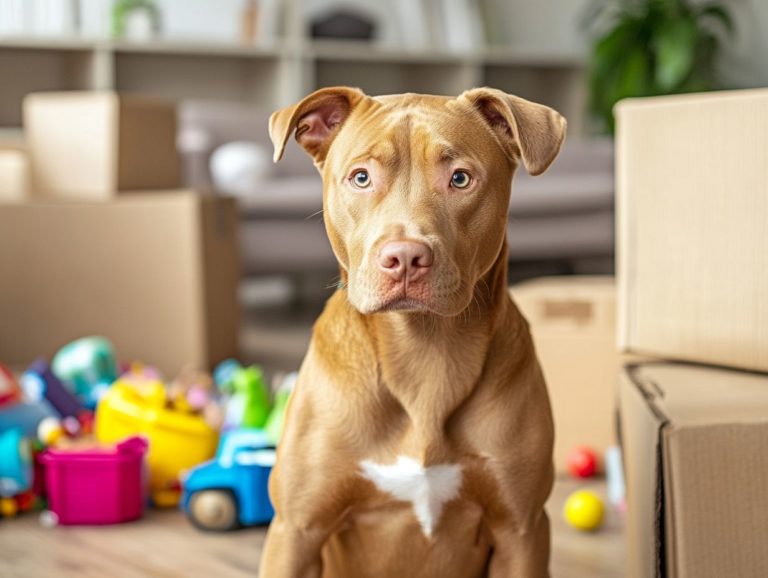How to Help an Anxious Pet Adjust to New Environments
Change can pose a challenge for your furry friends, often triggering anxiety when they encounter new environments or shifted routines.
Understanding how pets respond to change is essential for their overall well-being. This article delves into effective strategies for preparing your pet for transitions, helping you recognize signs of anxiety, and implementing calming techniques.
You ll also discover when it s time to seek professional assistance and explore long-term strategies to foster resilience in your pet.
Let s work together to make your pets feel safe and comfortable!
Contents
- Key Takeaways:
- The Impact of Change on Pets
- Preparing for a Change in Environment
- Managing Anxiety in Pets
- Seeking Professional Help
- Long-Term Strategies for Helping Anxious Pets
- Frequently Asked Questions
- What can I do to help my anxious pet adjust to a new environment?
- Should I gradually introduce my pet to the new environment or just let them explore?
- What are some signs that my pet is feeling anxious in their new environment?
- What calming techniques can I use to help my pet adjust to the new environment?
- How long does it usually take for a pet to adjust to a new environment?
- Should I consult a veterinarian if my pet is struggling to adjust to the new environment?
Key Takeaways:

- Understand your pet’s anxiety and how change impacts them.
- Create a safe and familiar space for your pet in the new environment.
- Utilize calming techniques and consider seeking professional help if needed.
The Impact of Change on Pets
Change can profoundly affect your pets, especially dogs, who are remarkably attuned to shifts in their surroundings. When you move to a new home or encounter unfamiliar situations, your dog may experience increased anxiety, which can show up as various stress behaviors.
This anxiety can take a toll on their overall well-being and upset their daily habits, leaving them feeling uncertain and insecure. Understanding what to do if your pet is anxious after moving is crucial for facilitating a smooth transition and fostering a confident, calm atmosphere.
Tapping into resources like the AKC GoodDog Helpline, which provides valuable dog training help, can offer you invaluable training tips to help alleviate your dog’s anxiety during these times of upheaval.
Understanding Anxiety in Pets
Understanding anxiety in pets, particularly dogs, requires recognizing the various signs and behaviors that indicate stress. You might notice changes in their body language, such as avoiding eye contact, excessive barking, or hiding, all of which can signal discomfort and anxiety in their environment.
Other common indicators include pacing, trembling, or baring teeth. These behaviors highlight their unease. While these signs may not always be immediately apparent, attentive pet owners like yourself can learn to identify subtle shifts in your dog’s demeanor.
For example, if a previously friendly dog suddenly becomes withdrawn or irritable, it could indicate an underlying issue. By recognizing these signs, you can take proactive steps to create a safe and reassuring atmosphere, ultimately fostering a bond built on trust and comfort, allowing your furry companion to feel secure and at ease.
Preparing for a Change in Environment
Preparing for a change in your dog s environment requires thoughtful planning to ensure a safe and familiar space. When you re moving, create a setup that mimics their previous surroundings to significantly ease the transition.
Maintain consistent routines, like feeding and exercise schedules, to provide your dog with the comfort and stability they need during this adjustment period.
Creating a Safe and Familiar Space

Creating a safe and familiar space for your dog in a new environment is essential for minimizing anxiety. This space should be filled with their favorite toys, a cozy bed, and familiar scents. Additionally, if your pet continues to struggle, consider learning how to seek help for your anxious pet to ensure their well-being.
To enhance this comforting setup, consider adding soft blankets that carry their scent; these can evoke feelings of warmth and safety. Placing items like a worn shirt or a piece of your clothing nearby can offer them emotional reassurance. It s wise to avoid sudden changes in their surroundings, as this can elevate their stress levels.
Gradually introduce them to different areas while maintaining a consistent routine to reinforce their sense of security and comfort. By providing a designated area where they can retreat and relax, you create a sanctuary that gives them control over their environment.
Managing Anxiety in Pets
Managing anxiety in your pets, especially dogs, requires a keen eye for recognizing signs of stress and employing effective calming techniques.
By understanding the specific behaviors linked to anxiety, you can more effectively address your pet’s needs and cultivate a nurturing environment that promotes tranquility. For guidance, check out how to recognize and address anxiety in pets.
Act now to help your pet adjust smoothly to changes!
Recognizing Signs of Anxiety
Recognizing the signs of anxiety in your dog is crucial for effective management. You might notice common behaviors like excessive barking, trembling, or shifts in body language. These can signal that your dog is feeling insecure or stressed.
Beyond these visible reactions, persistent pacing or hiding may signal deep discomfort. A lowered tail and flattened ears often reflect fear. It’s also important to pay attention if your dog exhibits repetitive behaviors, such as licking or chewing on themselves. These actions can be ways to feel better from their stress.
Changes in appetite whether they re eating too little or overeating are further signs of anxiety that you shouldn t overlook. Understanding these signals is essential for creating a supportive environment that allows your dog to feel safe and secure.
Calming Techniques and Products
Employing calming techniques and products can significantly alleviate anxiety in your dog. Consider options like chew toys and puzzle toys. They not only serve as distractions but also provide essential mental stimulation, aiding in the overall calming process.
You can also try calming supplements such as hemp-derived oils and treats. These have proven effective in promoting relaxation and reducing stress levels. These products can work magic for anxious dogs, especially during loud noises or unfamiliar situations, delivering a soothing effect that enhances their emotional well-being.
Playing gentle, calming music and using pheromone diffusers, which release calming scents, can create a comforting atmosphere. This encourages a more serene state for your furry friend. By exploring these diverse options, you can discover the best combination tailored to your dog’s specific needs, ultimately fostering a happier, more relaxed canine companion.
Seeking Professional Help

Seeking professional help is essential when it comes to managing severe anxiety in dogs. By consulting a veterinarian or a skilled dog trainer, you gain access to tailored strategies and interventions specifically designed to address your dog’s unique needs.
When to Consult a Veterinarian or Trainer
Understanding when to consult a veterinarian or trainer is essential for effectively addressing your dog’s anxiety. If you notice your dog displaying persistent signs of distress, like excessive barking or withdrawing from activities, don t wait seek professional advice today!
Recognizing these signs early is crucial in preventing the anxiety from escalating. It can significantly impact your pet’s overall well-being. A veterinarian can evaluate any underlying medical issues that might be contributing to the anxiety, while a trainer focuses on behavioral interventions.
It’s important to remember that anxiety is not just a passing phase; it can seriously affect your dog’s quality of life if left untreated. By seeking guidance from these professionals, you ensure a comprehensive approach to developing effective coping strategies, underscoring the importance of timely intervention.
Long-Term Strategies for Helping Anxious Pets
Implementing long-term strategies for supporting anxious pets is essential for fostering resilience and developing effective coping skills over time. This approach involves consistent training, positive reinforcement, and establishing a structured routine. All of these work together to build confidence in dogs.
By prioritizing these methods, you enable your pet to navigate their anxieties with greater ease and assurance.
Building Resilience and Coping Skills
Building resilience and coping skills in your pet is crucial for managing anxiety over the long term. By maintaining consistent training and a stable routine, it provides a sense of comfort that helps your pet adapt more effectively to changes and unfamiliar situations. Consider exploring helpful tips for reducing pet anxiety to support your efforts.
Using positive reinforcement encourages good behavior that fosters confidence. Regular training sessions not only build trust but also strengthen the bond between you and your pet. Establishing a predictable daily schedule significantly reduces uncertainty, making your pet feel more secure in its environment.
Activities like interactive play and puzzle toys enhance coping skills even further, providing healthy outlets for excess energy and frustration. These fun activities not only ease anxiety but also keep your furry friend happy and healthy!
Frequently Asked Questions

What can I do to help my anxious pet adjust to a new environment?
First, create a safe and comfortable space for your pet to retreat to. This can be a designated room or area with their favorite toys, bed, and blankets. It should be a quiet and calm space to help ease their anxiety, and you can learn more about this in our guide on how to support your anxious pet after training.
Should I gradually introduce my pet to the new environment or just let them explore?
Gradual introductions are recommended, especially for pets who are easily overwhelmed. Start with short visits to the new environment and consider using tips for training anxious pets at home to gradually increase the duration as your pet becomes more comfortable.
What are some signs that my pet is feeling anxious in their new environment?
Common signs of anxiety in pets include:
- Pacing
- Excessive drooling
- Shaking
- Hiding
- Loss of appetite
You may also notice changes in their behavior, such as increased aggression or clinginess.
What calming techniques can I use to help my pet adjust to the new environment?
Yes, there are several techniques you can try, such as using calming pheromone sprays, playing soothing music, or using a Thundershirt. Additionally, implementing the top 10 environmental adjustments for anxious pets can help create a more comforting space for your furry friend. You can also try using positive reinforcement training to help your pet associate the new environment with positive experiences.
How long does it usually take for a pet to adjust to a new environment?
The adjustment period varies for each pet, but it typically takes around 2-3 weeks for them to fully adapt to their new surroundings. However, some pets may take longer, so it’s important to be patient and understanding during this transition.
Should I consult a veterinarian if my pet is struggling to adjust to the new environment?
If your pet’s anxiety is severe and affecting their daily life, it’s best to consult a veterinarian. They can provide guidance and may recommend techniques to help pets adjust to new environments or additional support to help your pet cope.






